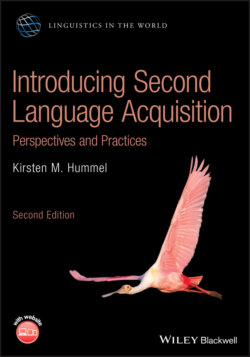Читать книгу Introducing Second Language Acquisition - Kirsten M. Hummel - Страница 26
2.4.3 L1 interactionist approach
ОглавлениеInteractionism and interactionist approaches to explaining L1 acquisition give explicit acknowledgment to the contribution of both innate structures and the role of the environment. In particular, the social interactionist view, which includes proponents such as Berko Gleason, the creator of the Wug test discussed in Section 2.3, argues that while there is substantial evidence that innate structures allow for language acquisition, the role of the environment is more important than acting as a simple trigger for development, as proposed in the linguistic approach. Social interactionists give importance to the interplay between linguistic structures, cognitive abilities, and the social and linguistic environment. Language is viewed as a communicative act and the language environment and the child constitute a dynamic system. Piper (1998, p. 161) sums up this approach in the following way:
interactionism
Theoretical viewpoint about L1 acquisition that recognizes the role of experience and the environment, as well as the contribution of innate capacities.
The question that is of primary interest in language acquisition theory is how children acquire the ability to express their intentions or meanings in language. [Social] interactionists believe that they do so through a process of negotiation with their mothers or principal caregivers. This negotiation occurs partly as a result of mothers treating children's speech, even if it is babbling, as meaningful and intentional.
Interactionists point out that a crucial aspect of the linguistic environment is the speech adaptations to which children are exposed. In many societies, although not all, children learning their native language are exposed to particular linguistic and paralinguistic (prosodic) adaptations; this has been referred to as child‐directed speech ( CDS ), parentese, or caregiver talk. Some of the common characteristics of CDS include shorter utterances, more stress on certain words or syllables, substantial repetition, use of paraphrases, heavy reliance on questions, and marked intonation contrasts. The following dialogue reveals substantial language adaptations by the child's mother. In this dialogue (Bloom, 1973), the mother and child are playing with a doll and toy truck. The child is 19 months old:
child‐directed speech (CDS)
Special speech register used by adults and older children when speaking to younger children and infants. Characteristics include exaggerated intonation and considerable repetition.
Allison:
Tumble (takes doll out of truck; knocks truck over).
Mother:
Tumble, tumble. Where is the truck going to go? Where will the truck go?
Allison:
brrm.
Mother:
Where?
Allison:
Pop Pop.
Mother:
Pop Pop? To see Pop Pop?
Allison:
No.
Mother:
No. Where will the truck go?
The mother in the preceding dialogue uses CDS when she repeats words (“tumble, tumble,” “pop pop”) and repetitive utterances are largely questions (“Where is the truck going to go?” “Where will the truck go?” “Where?”). The extent to which such adaptations help, hinder, or are neutral to a child's L1 progress is under debate, but many researchers suggest that CDS may in fact make it easier for the child to pick out the important segments in speech. Studies have found, for instance, that children with mothers who tend to talk more per unit of time display a more rapid vocabulary growth (e.g. Huttenlocher et al. 1991). CDS has been found to occur across languages. For example, in a study of Mandarin speakers in Taiwan (Liu et al. 2009), it was found that mothers used longer vowels, higher pitch and greater lexical tone differences when speaking with their children.
The interactionist approach has been criticized for making certain assumptions that remain untested. In essence, the critique is made that CDS is actually not all that simple and therefore may not be inherently helpful in allowing the child to acquire language. Still, there is evidence from Inuktitut, a language spoken by Inuit people in the Arctic, that CDS can be structurally quite complex, yet still appears to facilitate children's acquisition of morphology in that language (Crago and Allen 1998). It has also been pointed out that some CDS features have not been found in a number of languages. If CDS is a necessary feature to allow for optimal language acquisition, one would expect to find it universally, cross‐culturally, and this is not the case. Ochs (1985), for instance, found little importance given to speech modifications to infants in Samoan society. Other studies have focused specifically on examining whether there is a direct relation between aspects of CDS and language gains. In this regard, Hoff‐Ginsburg (1986) found no relation between the complexity of the mother's speech and children's language gains.
Cartoon 2.2 Mike Williams/CartoonStock.com.
